Harvested Seaweeds of Maine
Ascophyllum nodosum – a.k.a. Rockweed, Knotted Wrack, Asco
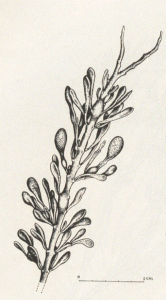 During the cold winter months, rockweed has a very dark green color. In the warmer summer months, portions of the plant will develop a gold, brown color. Anchored to rocks with a disc-shaped holdfast, the stipe divides into a series of branched fronds, each interspersed with air bladders. To distinguish from bladderwrack, note the bladders are not paired and the absence of midribs. During the reproductive cycle (March through June), yellow, spore-bearing receptacles develop throughout the plant. The total length of a mature plant can vary from 3 to 5 feet, or more.
During the cold winter months, rockweed has a very dark green color. In the warmer summer months, portions of the plant will develop a gold, brown color. Anchored to rocks with a disc-shaped holdfast, the stipe divides into a series of branched fronds, each interspersed with air bladders. To distinguish from bladderwrack, note the bladders are not paired and the absence of midribs. During the reproductive cycle (March through June), yellow, spore-bearing receptacles develop throughout the plant. The total length of a mature plant can vary from 3 to 5 feet, or more.
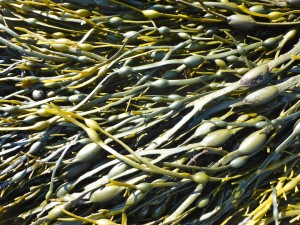 Rockweed grows in the rocky mid to lower intertidal zone. It can be found in protected coves as well as in more open areas. The size of the stipe and air bladders will vary depending on the nutrient levels in the water, the strength of the water flow, and the age of the plant.
Rockweed grows in the rocky mid to lower intertidal zone. It can be found in protected coves as well as in more open areas. The size of the stipe and air bladders will vary depending on the nutrient levels in the water, the strength of the water flow, and the age of the plant.
Ascophyllum nodosum, f. scorpioides – a.k.a. Wormweed
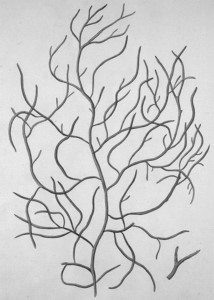 Mature fronds are yellow in color. A short stipe from the holdfast gives way to multiple branches or “fingers” that intertwine with neighboring plants to form hand-sized or larger clusters. Small air bladders are interspersed throughout the plant and yellowy-orange spore sacs may be noticeable during the plant’s reproductive phase.
Mature fronds are yellow in color. A short stipe from the holdfast gives way to multiple branches or “fingers” that intertwine with neighboring plants to form hand-sized or larger clusters. Small air bladders are interspersed throughout the plant and yellowy-orange spore sacs may be noticeable during the plant’s reproductive phase.
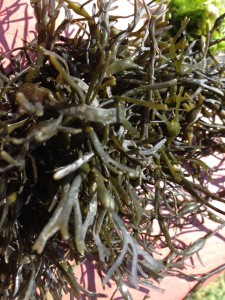 Wormweed is usually found near the high tide mark in the grasses of salt-water marshes and highly protected areas. Its holdfast is easily dislodged in storms, allowing it to sometimes drift and accumulate in sheltered coves.
Wormweed is usually found near the high tide mark in the grasses of salt-water marshes and highly protected areas. Its holdfast is easily dislodged in storms, allowing it to sometimes drift and accumulate in sheltered coves.
Fucus vesiculosus – a.k.a. Bladderwrack, Fucus
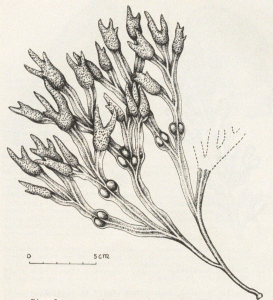 Mature fronds are olive-green with leathery texture. A mid rib and bladders on a moderately narrow blade is characteristic of these species. The bladders are paired on either side of the midrib on F. vesiculosus (see figure). Plants reach 8 to 35 in. long and are attached to a disc-shaped holdfast through a short-wiry stipe.
Mature fronds are olive-green with leathery texture. A mid rib and bladders on a moderately narrow blade is characteristic of these species. The bladders are paired on either side of the midrib on F. vesiculosus (see figure). Plants reach 8 to 35 in. long and are attached to a disc-shaped holdfast through a short-wiry stipe.
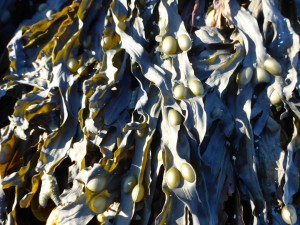 Bladderwrack can be found in the rocky intertidal and upper subtidal zones in exposed to protected coasts in bays and estuaries. It is often found mixed with rockweed (Ascophyllum nodosum) plants. However, pure stands are usually found below or above A. nodosum. It is also predominant in areas of more perturbed substrate (ice scour or small rock/gravel).
Bladderwrack can be found in the rocky intertidal and upper subtidal zones in exposed to protected coasts in bays and estuaries. It is often found mixed with rockweed (Ascophyllum nodosum) plants. However, pure stands are usually found below or above A. nodosum. It is also predominant in areas of more perturbed substrate (ice scour or small rock/gravel).
Saccharina latissima – a.k.a. Sugar Kelp, Oarweed, Sea Belt
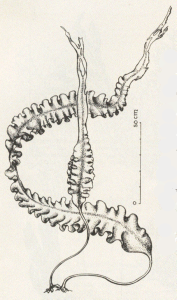 Mature plants vary considerably in size from 5 – 25 ft. long and 10 – 20 inches wide. Anchored by a large branched holdfast, the stipes can be long and hollow (the longicruris form) or short and solid (the saccharina form). The large, flat, olive to golden fronds can have ruffled edges and bullations, or they can be smooth and strap-like.
Mature plants vary considerably in size from 5 – 25 ft. long and 10 – 20 inches wide. Anchored by a large branched holdfast, the stipes can be long and hollow (the longicruris form) or short and solid (the saccharina form). The large, flat, olive to golden fronds can have ruffled edges and bullations, or they can be smooth and strap-like.
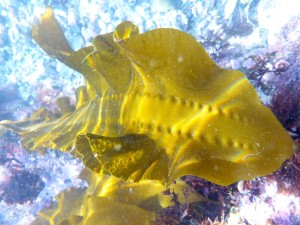 This species of kelp is found in the near shore, subtidal zone, preferring more protected bays, coves and estuaries than S. digitata. Holdfasts attach to ledges, stones, mussels, pilings, even ropes – forming dense beds where substrate is firm, to thin clumps where bottoms are mostly mud. It can tolerate brackish water, tidepools, and strong currents, especially in areas of continuous flow, such as is found in reversing falls.
This species of kelp is found in the near shore, subtidal zone, preferring more protected bays, coves and estuaries than S. digitata. Holdfasts attach to ledges, stones, mussels, pilings, even ropes – forming dense beds where substrate is firm, to thin clumps where bottoms are mostly mud. It can tolerate brackish water, tidepools, and strong currents, especially in areas of continuous flow, such as is found in reversing falls.
Laminaria digitata – a.k.a. Horsetail Kelp, Fingered Kelp, Digitata
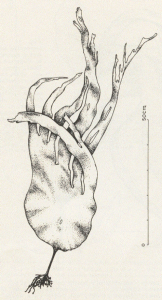 Mature plants are olive brown to almost black, and rubbery to the touch. Dense holdfasts lead to short solid stipes of 6 to 12 in., supporting broad thick blades that quickly separate into multiple “fingers”, each 1 to 3 in. wide and 1 to 5 ft. long.
Mature plants are olive brown to almost black, and rubbery to the touch. Dense holdfasts lead to short solid stipes of 6 to 12 in., supporting broad thick blades that quickly separate into multiple “fingers”, each 1 to 3 in. wide and 1 to 5 ft. long.
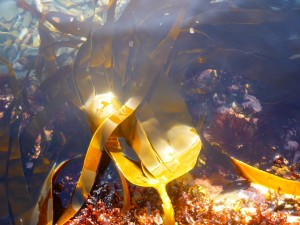 Fingered kelp thrives in cold, turbulent water just below the intertidal zone to very deep sublittoral, occasionally seen at the surface at the very lowest tides, or in tide pools. Deep beds are dense, shallow beds are sometimes mixed with Alaria esculenta, or occasionally S. latissima.
Fingered kelp thrives in cold, turbulent water just below the intertidal zone to very deep sublittoral, occasionally seen at the surface at the very lowest tides, or in tide pools. Deep beds are dense, shallow beds are sometimes mixed with Alaria esculenta, or occasionally S. latissima.
Alaria esculenta – a.k.a. Winged Kelp, Alaria
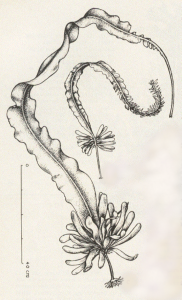 Alaria’s color varies from golden olive to almost black. Mature 1st year plants range in length from 6-12 ft. and 3-6 in. wide. 2nd year plants may be up to 12 in. wide and much longer (or severely truncated by winter storms). Their most distinctive characteristic is a short, flattened stipe that becomes the midrib that runs through the thin, ruffled frond. These sturdy midribs allow blades to survive strong wave action. At the base of the main frond is a set of reproductive spatulate fronds called sporophylls, 2-4 in. long in 1st yr. plants, longer and thicker in 2nd yr. plants.
Alaria’s color varies from golden olive to almost black. Mature 1st year plants range in length from 6-12 ft. and 3-6 in. wide. 2nd year plants may be up to 12 in. wide and much longer (or severely truncated by winter storms). Their most distinctive characteristic is a short, flattened stipe that becomes the midrib that runs through the thin, ruffled frond. These sturdy midribs allow blades to survive strong wave action. At the base of the main frond is a set of reproductive spatulate fronds called sporophylls, 2-4 in. long in 1st yr. plants, longer and thicker in 2nd yr. plants.
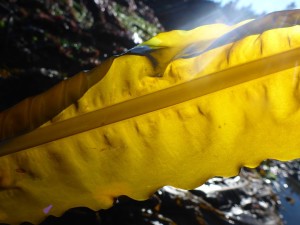 Alaria is usually found on rocky ledges just below low tide, predominantly on wave-exposed rocky peninsulas and outer islands on the Maine coast. First year plants may grow slightly higher and survive a few hours of exposure at the spring tides. Sometimes intermixed with S. digitata.
Alaria is usually found on rocky ledges just below low tide, predominantly on wave-exposed rocky peninsulas and outer islands on the Maine coast. First year plants may grow slightly higher and survive a few hours of exposure at the spring tides. Sometimes intermixed with S. digitata.
Palmaria palmata – a.k.a. Dulse
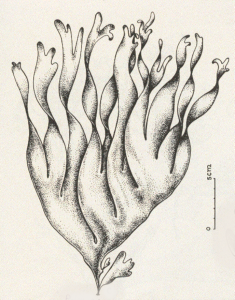 Mature fronds are rose red to reddish purple, 6-10 in. long, 4-6 in. wide. Tiny disc-shaped holdfasts widen immediately into thin elastic fronds that segment into lobes or “stubby fingers.” The plant is hand shaped and hand sized. Dried fronds are dark red to black with fronds stuck together or layered.
Mature fronds are rose red to reddish purple, 6-10 in. long, 4-6 in. wide. Tiny disc-shaped holdfasts widen immediately into thin elastic fronds that segment into lobes or “stubby fingers.” The plant is hand shaped and hand sized. Dried fronds are dark red to black with fronds stuck together or layered.
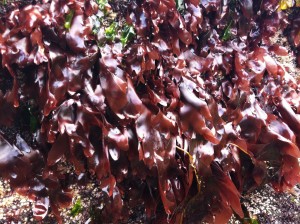 Usually found attached to rocks, shells or other seaweeds from mid tide to 10 to 20 ft. below the intertidal zone. Dulse often hangs from rock faces or crevices, intermixed with rockweed. On the Maine coast it seems to flourish on rocky outcroppings with moderate turbulence, in nutrient rich reversing falls areas and anywhere there is good current.
Usually found attached to rocks, shells or other seaweeds from mid tide to 10 to 20 ft. below the intertidal zone. Dulse often hangs from rock faces or crevices, intermixed with rockweed. On the Maine coast it seems to flourish on rocky outcroppings with moderate turbulence, in nutrient rich reversing falls areas and anywhere there is good current.
Chondrus Crispus – a.k.a. Irish Moss
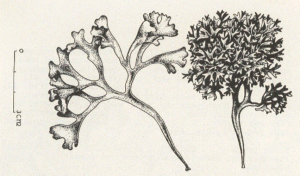 Mature fronds vary from purple to green in color and are 2-6 in. long. Fronds are branched dividing in two at each branching point The stipes are flat and vary from 1/16 in. near the holdfast to 1/2 in. in width. Growth from holdfasts is bushy to loose. Fronds are longer and less bushy in areas of lower water velocity and vary from dark to pale green when deprived of nutrients.
Mature fronds vary from purple to green in color and are 2-6 in. long. Fronds are branched dividing in two at each branching point The stipes are flat and vary from 1/16 in. near the holdfast to 1/2 in. in width. Growth from holdfasts is bushy to loose. Fronds are longer and less bushy in areas of lower water velocity and vary from dark to pale green when deprived of nutrients.
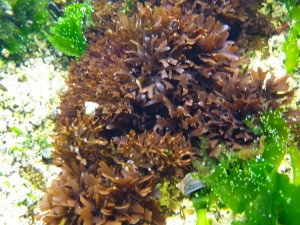 Irish Moss is usually found attached to ledge and rocks sufficiently stable to allow the plant to remain stationary in rapid seawater movement. It thrives in high-energy environments and can be found on ledges exposed to strong wave action or in areas of fast current. It occurs at depths from just above low water to approximately 20 feet or more depending on availability of light. Irish Moss is found both in pure stands and mixed with other seaweed.
Irish Moss is usually found attached to ledge and rocks sufficiently stable to allow the plant to remain stationary in rapid seawater movement. It thrives in high-energy environments and can be found on ledges exposed to strong wave action or in areas of fast current. It occurs at depths from just above low water to approximately 20 feet or more depending on availability of light. Irish Moss is found both in pure stands and mixed with other seaweed.
Porphyra spp. – a.k.a. Laver, Nori
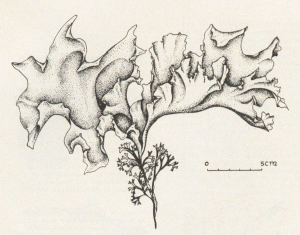 At least 5 different varieties of this red seaweed are found along the Maine coast. Ranging in color from gray-black (P. umbilicalis) to rose red (P. miniata), all plants are stipeless with a single thallus, or leaf, emerging directly from a disc shaped holdfast. Sizes range from small (2-4 in.) and round (P. umbilicalis and P. leucosticta) to large (1-3 ft.) and long (P. miniata and P. amplissima).
At least 5 different varieties of this red seaweed are found along the Maine coast. Ranging in color from gray-black (P. umbilicalis) to rose red (P. miniata), all plants are stipeless with a single thallus, or leaf, emerging directly from a disc shaped holdfast. Sizes range from small (2-4 in.) and round (P. umbilicalis and P. leucosticta) to large (1-3 ft.) and long (P. miniata and P. amplissima).
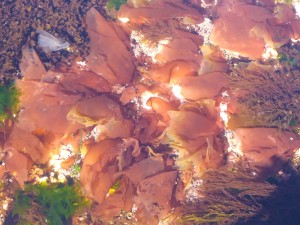 P. umbilicalis and P. linearis are mostly found in the mid to upper intertidal zone attached to rock faces and crevices, also ropes, pilings and moorings. P. leucosticta usually grows on rocks and even kelp stipes just below the mean low mark. P. miniata and P. amplissima both prefer the subtidal zone and will grow quite large in currents.
P. umbilicalis and P. linearis are mostly found in the mid to upper intertidal zone attached to rock faces and crevices, also ropes, pilings and moorings. P. leucosticta usually grows on rocks and even kelp stipes just below the mean low mark. P. miniata and P. amplissima both prefer the subtidal zone and will grow quite large in currents.
Ulva lactuca – a.k.a. Sea Lettuce
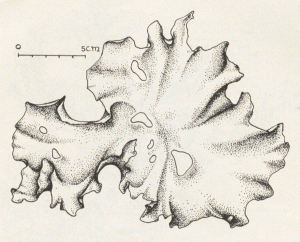 Fronds are bright spring green and leaf-like with undulating wide blades. Blades are up to 8 in tall, heart-shaped, oval or nondescript, occasionally with some small holes. They are like waxed paper to touch.
Fronds are bright spring green and leaf-like with undulating wide blades. Blades are up to 8 in tall, heart-shaped, oval or nondescript, occasionally with some small holes. They are like waxed paper to touch.
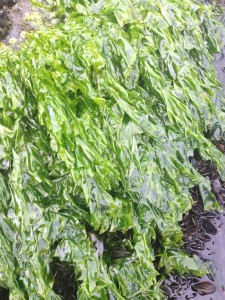 Sea lettuce is found in moderately exposed situations on rocks, wood pilings, mussel beds, in pools and quiet shallow waters near the low tide mark. It thrives in brackish water with high organic matter with high levels of nitrogen, and can be found in coastal waters all over the world and all year around.
Sea lettuce is found in moderately exposed situations on rocks, wood pilings, mussel beds, in pools and quiet shallow waters near the low tide mark. It thrives in brackish water with high organic matter with high levels of nitrogen, and can be found in coastal waters all over the world and all year around.
Drawings by Priscilla Fawcett
Used by permission of Farlow Herbarium, Harvard University
Cambridge, MA 02138
Photographs by Sarah Redmond, Maine Sea Grant